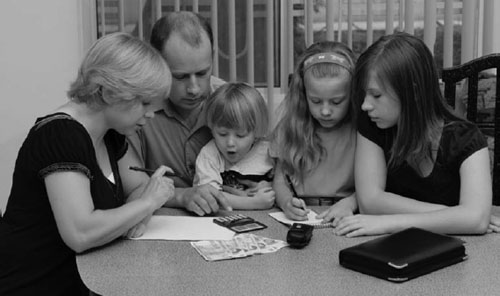IntroductionOur Financial Mindset |
What are some basic steps in our personal finance journey? |
There are several steps that we must all take in our pursuit of personal financial management. We have to begin by really thinking of, and assessing our attitudes toward, money and focus on what thoughts or attitudes seem to be blocking our ability to attain our financial goals. Many of these concepts started at an early age by observing how our parents dealt with financial issues. The good thing is that all of the beliefs and attitudes about money that are blocking us can easily be changed. We have to begin to read and learn about personal finance, by using all the information available to us, like searching the Internet, reading magazines on personal finance, paying attention to the business and financial section of the newspaper, and watching personal financial shows on television and online.
It may seem a bit intimidating at first, but after a while the information begins to make sense. You begin to see how small economic changes affect things like today’s stock price, but not next year’s stock price. You begin to see what economic variables affect each other, why the price of oil, or the interest rate in a far-away capital like Tokyo or London, is so critical to the economy. We have to assess our financial picture and have a truthful and open view of where we are in terms of our income and expenses. Can I improve my income this year? Am I even trying to improve my skills, work better than others, and ask for the raise? We have to look at our expenses and see where the overages are. Do we make enough money to go out for dinner three nights a week? We have to see if we have at least six months’ of emergency funds that we never touch, in case of a job change, or costly personal event, so that we can ride through it before we settle again. And we must consider paying ourselves first a certain percentage of our income each pay period, never touching these funds unless they are in support of some financial goal, like education, retirement like education, retirement, etc.
We have to design attainable goals, both short- and long-term. This allows us to build our confidence that we can actually attain a goal before moving on to the next. It allows us to visualize a long-term goal and not let our current desire to buy that new thing get in the way of attaining our long-term goal. Once we have our goals in mind, it’s time to execute our strategies to attain our goals. By this point, we have some ideas or strategies in place that help us reach our short-term goals and long-term goals. We may decide to begin taking money out of our paycheck and directing it to a retirement fund. We may decide to sell the leased car and buy a cheaper used car, and begin saving the monthly payment that we used to make, each month. All of a sudden, after 12 months, we find that we have an additional $2,400 available to invest. Our personal finance journey also involves learning how to analyze our performance and how good we are at meeting our short and long-term goals:
- Should we cut out the investments that are doing poorly in the short-term?
- Do we have too much money tied into our real estate?
- Should we now move from keeping cash to investing in mutual funds?
It’s important to look at the performance of our portfolio in order to make sure that it is helping us meet our goals, or make the necessary changes. And finally, personal finance teaches us to have the flexibility to occasionally re-adjust our goals and strategies along the way, and make adjustments in both our spending habits and savings habits, depending on what events life throws at us. We learn how to make the right choices at the right times, and see opportunity to improve our methods and strategies as we reach different stages in our lives.
| Year | Mean Income* | Median Income | |||
| 1980 | $52,202 | 43,892 | |||
| 1981 | $51,565 | 43,163 | |||
| 1982 | $51,879 | 43,048 | |||
| 1983 | $51,990 | 42,747 | |||
| 1984 | $54,002 | 44,074 | |||
| 1985 | $55,255 | 44,898 | |||
| 1986 | $57,434 | 46,488 | |||
| 1987 | $58,539 | 47,071 | |||
| 1988 | $59,266 | 47,433 | |||
| 1989 | $60,996 | 48,279 | |||
| 1990 | $59,505 | 47,637 | |||
| 1991 | $58,242 | 46,269 | |||
| 1992 | $58,177 | 45,888 | |||
| 1993 | $60,556 | 45,665 | |||
| 1994 | $61,731 | 46,175 | |||
| 1995 | $62,802 | 47,622 | |||
| 1996 | $64,148 | 48,315 | |||
| 1997 | $66,214 | 49,309 | |||
| 1998 | $68,145 | 51,100 | |||
| 1999 | $70,462 | 52,388 | |||
| 2000 | $71,165 | 52,301 | |||
| 2001 | $70,521 | 51,161 | |||
| 2002 | $68,976 | 50,563 | |||
| 2003 | $68,886 | 50,519 | |||
| 2004 | $68,662 | 50,343 | |||
| 2005 | $69,597 | 50,899 | |||
| 2006 | $70,819 | 51,278 | |||
| 2007 | $69,940 | 51,965 | |||
| 2008 | $68,164 | 50,112 | |||
| 2009 | $67,976 | 49,777 | |||

Average family income in the United States has taken a downward turn in the twenty-first century. Some economists fear that the next generation of Americans will be the first in over a century that actually earns less than the preceding generation.
